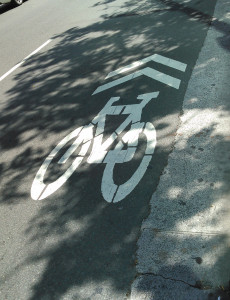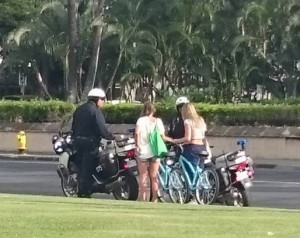I had always considered Shared Lane Markings, or sharrows, a cop-out, something that localities add when they want to look like they’re doing something to enhance cycling infrastructure but don’t want to make any actual changes. My cousin recently sent me this article, which in turn was based on this study that compared ridership and injuries before and after the addition of bike lanes or sharrows. Based on data about bike commuters in Chicago, the study found that the addition of bike lanes led to an increase in ridership and a decrease in injuries, while the addition of sharrows led to minimal changes compared with roads that had no changes in markings.
This started me thinking about sharrows in a larger context, and wondering whether they could have a negative impact on cyclists. For example, Hawaii law grants a bicycle the same rights as a car on a roadway (§291C-142). However, would sharrows on some roads lead drivers to the mistaken belief that cyclists are not allowed to ride on other roads that don’t have them? After giving this some thought, I’m of the mind that sharrows can be useful when used appropriately, but we shouldn’t consider them a major infrastructure improvement.
What Are Sharrows?
 Sharrows are the bike and double-chevron markings painted on the road to indicate a mixed use lane. They let drivers know to expect bikes in the lane, and they let bicyclists know where they are expected to ride. For example, they are usually placed 3-4 feet beyond parallel parking spaces, to keep cyclists from getting hit by car doors. This is how they are used along Dole Street, just east of the UH-Manoa campus. They are also used to connect bike lane segments, when a small portion of a road is too narrow for a full bike lane. This is the case along Waialae Avenue Koko Head-bound between 5th and 6th, so they could keep a left turn lane into Sacred Hearts.
Sharrows are the bike and double-chevron markings painted on the road to indicate a mixed use lane. They let drivers know to expect bikes in the lane, and they let bicyclists know where they are expected to ride. For example, they are usually placed 3-4 feet beyond parallel parking spaces, to keep cyclists from getting hit by car doors. This is how they are used along Dole Street, just east of the UH-Manoa campus. They are also used to connect bike lane segments, when a small portion of a road is too narrow for a full bike lane. This is the case along Waialae Avenue Koko Head-bound between 5th and 6th, so they could keep a left turn lane into Sacred Hearts.
I can tell you first hand that the transition from bike lane to sharrow along Waialae Avenue can be awkward when traffic is light, and particularly dangerous when there’s a lot of traffic turning into Sacred Hearts. However, as someone who use to commute along Waialae before they repaved it, I much rather have a partial bike lane than none. In this instance, a sharrow is a reasonable compromise to get a bike lane along the rest of the route.
Multiple Uses for Sharrows
At first I was worried that, as sharrows become more common, car drivers would think that bikes don’t belong on roads without them. I’m still concerned that this may be the case, but I understand the need to heighten awareness along some roads. In fact, there is a stretch of Farrington Highway that is in particular need of them. When riding from town to Kalaeloa (or any place Ewa/Waianae ways), you have two very nice stretches of off-street bike paths: the Pearl Harbor Bike Path and along Fort Weaver Road. However, to get from one to the other, you have to ride a mile and a half along Farrington Highway. The road is narrow, busy, and, in the ewa-bound direction, partially uphill. This would be the perfect place to add sharrows. Besides alerting drivers to potential bikes in the right lane, it also makes it clear to cyclists that they need to ride in the road along this stretch and not on the sidewalk.
While reading some background for this article, I realized that sharrows can also be used to help direct cyclists. The chevrons don’t just have to point forward; they can direct cyclists left or right along the safest bike route. I learned firsthand using Vélib’ bike share in Paris that navigating a new city can be difficult at best, but is especially daunting when the cycling infrastructure is not continuous. It’s easy to get confused and ride where you’re not supposed to when, along the course of one street, the bike route changes from a bike lane to a shared use lane, then to a bike path shared with a sidewalk, then to a separate bike path, then back to a shared use lane (even though the sidewalk continues).

HPD conducts targeted enforcement of tourists riding on the sidewalk trying to reach the King Street Protected Bike Lane.
This will become increasingly necessary in Honolulu as we will soon have many more visitors on bikes through Bikeshare Hawaii. We are working toward a minimum grid, but are far from it right now. Our cycling network is disjointed, with individual segments that don’t connect together. Directional sharrows are one way to show visitors where best to avoid dangerous roads, or where to stay off sidewalks in areas where cycling is not allowed (such as Waikiki or Downtown). And, to expand on my Farrington Highway mention above, in the town-bound direction, a directional sharrow indicating a right turn onto Waipahu Depot Road would keep cyclists new to the area from missing the entrance to the Pearl Harbor Bike Path.
Developing a New View of Sharrows
I never thought much of sharrows. They always seem to be a way for a locality to say they were working hard for cyclists, but without actually doing anything useful. They don’t increase the distance between cars and bicycles or provide any protection; consequently, I’m not surprised that the Chicago study mentioned above found that there was no significant decrease in injuries when only sharrows are added to a road. However, there are useful benefits to adding sharrows, such as heightened awareness of drivers and as directional aids for cyclists. They are absolutely no replacement for a separate bike lane. But, they are relatively cheap to add, and when I think of some of the more dangerous roads that I ride on (such as Farrington Highway), I hope to see more in the near future.
